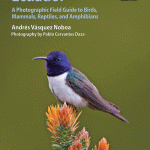Reptiles and Amphibians
Wildlife of Ecuador: A Photographic Field Guide to Birds, Mammals, Reptiles, and Amphibians by naturalist Andrés Vásquez Noboa, witih photography byablo Cervantes Daza, covers mainland Ecuador (but by "mainland" we also mean ocean mammals). Focusing only on non-piscine verts, you will need to go elsewhere for your inverts and plants and such. But you get the point. This book covers most of what you are looking for when you are out in the wild looking for animals.
This is not a comprehensive guide, but covers the most frequently seen animals, totaling to 350 distributed across over 400…
The American alligator is found only in the US, and is widespread in Texas. It is found at several inland localities, and along the coast. And, it turns out that the preferred locations for many of the important activities in the day to day live of the American alligator overlap a great deal with humans.
Louise Hayes, biologist, and photographer Philippe Henry have produced, with TAMU Press, Alligators of Texas, a highly accessible, well written, and richly illustrated monograph on these beasts.
If you are into Alligators and their relatives, regardless of where you live, this book may…
Salamanders can be a proxyindicator for climate change. Changes in salamanders have been linked to climate changes during ancient times, and in a very recent study, salamanders in the US Appalachians seem to have changed in relation to anthropogenic global warming. In fact, the changes observed in these Appalachian salamanders is quite large, very rapid, and thus, alarming. I’m going to describe this study in some detail, and as a bonus for sticking with me on this, I’ll throw in some entertaining Climate Science Denialism near the end. As an additional bonus prize, you’ll get a nice new…
I have never actually seen a snake eat a crocodile or a crocodile eat a snake, but I am pretty sure I've seen a snake planning to eat a Nile Croc. And that was in the geological present.
In the geological past, about 60 million years ago (during the "Eocene" a.k.a. "dawn age") there was a rain forest that is sort of the ancestor to modern rain forests, which is now a coal deposit (and thus, eventually, will be part of our air) in Columbia. It has yielded interesting materials, and the latest report, just published, is of a fossil dyrosaurid crocodyliform (ancient croc ancestor). It is…
tags: Life, Discovery Channel, Reptiles and Amphibians, Waterfall Toad Leap from Danger, animals, mammals, birds, BBC, television, streaming video
Gail Weiswasser at the Discovery channel emailed a few days ago to tell me about TONIGHT's premiere on the Discovery Channel of BBC's LIFE, the 11-part follow up to PLANET EARTH (the most successful natural history documentary of all time). While PLANET EARTH told the story of the natural world through the framework of our planet's ecosystems and regions, LIFE takes us on a more intimate journey, introducing different animal and plant groups, using…
tags: Life, Discovery Channel, Reptiles and Amphibians, Komodo Dragons Hunt Buffalo, animals, mammals, birds, BBC, television, streaming video
Gail Weiswasser at the Discovery channel emailed a few days ago to tell me about the upcoming March 21 premiere on the Discovery Channel of BBC's LIFE, the 11-part follow up to PLANET EARTH (the most successful natural history documentary of all time). While PLANET EARTH told the story of the natural world through the framework of our planet's ecosystems and regions, LIFE takes us on a more intimate journey, introducing different animal and plant…
One day, about six thousand years ago (or more like 15 thousand ? the timing of this is disputed) a volcano in the vicinity of Mwea, Uganda blasted a huge volume of stuff into the air, covering the surrounding landscape and choking off most of the life forms living in a nearby lake. (A very nearby lake ? the current configuration of the lake suggests that the volcano may have actually been beneath the lake at the time of the eruption).
A repost
Over a very short period of time, we can presume that the land animals that would have been wiped out by this eruption returned to the area,…
From the BBC:
Wildlife officials in Australia are investigating how an alligator native to North America was found wandering around a campsite in New South Wales.
Campers at the site in Pambula managed to snare the beast in a volleyball net and held its jaws shut.
Police first issued a press statement saying it was an indigenous crocodile but later corrected their error.
The animal's origins remain a mystery as no owners are registered locally either for crocodiles or alligators.
Well, that beats my story.
As you can see, this specimen of Leptotyphlops carlae is small enough to hang out on a US quarter. Scientists are still working out why this snake associates itself with coinage.
But seriously, this snake was discovered by Blair Hedges, an evolutionary biologist at Pennsylvania State University, who is famous for also having discovered the world's smallest gecko in 2001 and the world's smallest frog in 1993 .
How does he do it?
According to Hedges, it is mostly a matter of luck.
"I turned a small rock and found it hiding underneath," he claimed in a recent press report. However, the…
You've probably heard that this is the year of the frog. But with all the hype about the election, the war, the economy, robots, and so on, it is easy to forget. The Wildlife Conservation Society has a nice frog slide show on this site, and a list of things you can do to save "the frog" and the ironically named "amphibian ark" (a joint effort of three major conservation organizations) has more.
(I say ironic because it is a biblical reference, and creationists don't believe in extinction ... I assume, or how could there be any species left since they don't believe in specialization ...…


